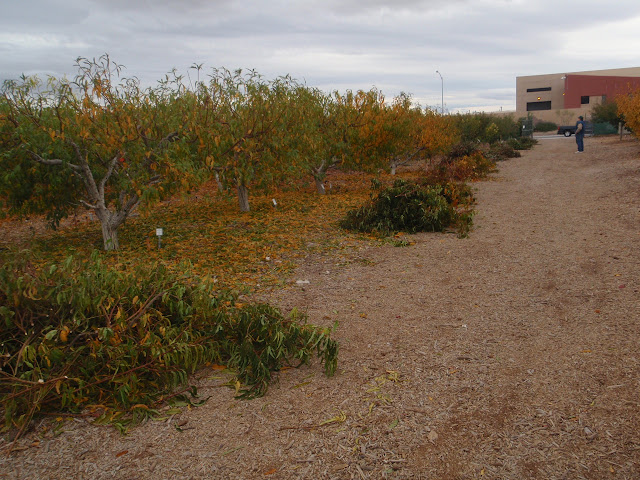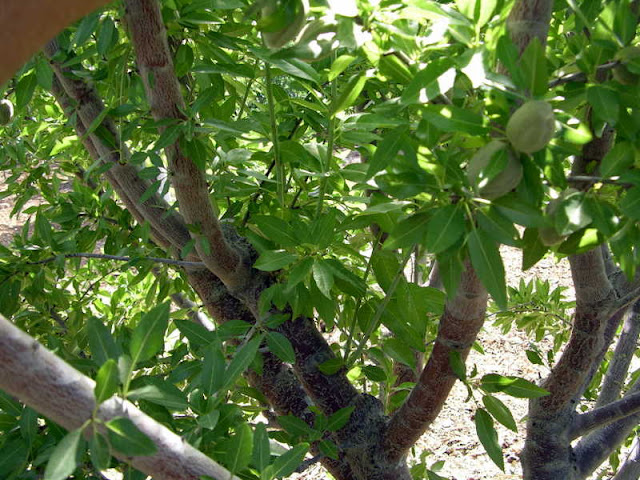Remember, stored fruit are ALIVE. They are still breathing (respiration) harvesting is done on climacteric fruit (peaches, nectarines, plums, apricots) when the fruit has changed color and lost most of its green color but still firm.
 |
| Climacteric fruit like these peaches are harvested when they have changed color but still firm. Harvesting climacteric fruit too early can result in poor flavor. |
Harvesters are told not to wear jewelry, wear gloves, and have short fingernails when harvesting. These can also cause damage to fruit. After harvesting, fruit is sorted by maturity and fruit skin abrasions, bruising and punctures. Damaged fruit is NEVER stored with non damaged fruit due to the release of ethylene gas and speed of ripening through damage.
 |
| Damaged fruit like this sun damaged apple is never stored with undamaged fruit. |
 |
| Nectarine damaged by thrips in the foreground. Damage is visual but too severe for the consumer. It is safe for storage but not suitable for sale. |
Harvest Time in Las Vegas
Peaches and nectarines- variable but there is a loss of dark green and change to either light green, yellow or red but fruit is still firm (solid to the feel). Oftentimes a penetrometer is used to gauge this for establishing values by fruit buyers and wholesalers. https://www.youtube.com/watch?v=y1VyPTA7vU4 In the field it is done by feel.
 |
| Peach fruit ready for harvest. Firm enough for harvest and mature enough for harvest. |
Plums – green plums when color change is from dark green to light green but fruit is still hard
Red plums when color change is from dark green to yellow or red and fruit is still hard.
 |
| Burbank plum firm, tree ripe and ready for harvest. |
Pears – some are green and some are red. Harvest pears AS SOON AS COLOR CHANGES TO GET A “BUTTERY” TEXTURE OTHERWISE TEXTURE IS GRITTY. Same as plums.
 |
| Correct color change for harvesting European pear. |
Asian pears - when fruit separates from the tree when lifted.
 |
| Asian pear, 'Shinko' ready for harvest. The fruit separates from the tree when lifted. |
Apricots – change in color from dark to light green but still firm.
 |
| Apricots ready to pick. Fruit shows little difference in quality when harvested a little bit early. Apriums are treated the same as apricots. |
Apples- near fully mature but still hard; this means color changes are important because what you harvest is what you get.
 |
| 'Pink Lady' apples, like all apples, are harvested when the seed is brown or by calendar. They ripen in November in Las Vegas. |
Quince – mildly climacteric with some improvement in maturity after picking. Pick when color changes and aroma begins.
 |
| Quince is harvested when the aroma from them is "floral" and, like apples, when the seeds are brown. I put my nose directly in the bottom (calyx end) and take a deep smell. When they start to give off an aroma, they are ripe. |
Pomegranate- by date or fully mature. Will store near freezing (colder than apples) for a long time.
 |
| Mature pomegranates will keep on the bush or tree for a month when they are ready. Harvest when fully ripe. Use a date for harvesting and know which variety you have. |
Persimmon- some persimmon are astringent and others are not. Nonastringent persimmon can be harvested anytime after color change. Astringent persimmon MUST only be harvested when firm but near harvest but eaten when soft.
 |
| Harvest nonastringent persimmon like 'Fuyu' when there is a color change. Harvest astringent types like 'Hachiya' when it is firm but fully red. Astringent types must be soft to be eaten when they are sweet. |
Grapes – nonclimacteric so harvested only when fully ripe; use refractometer. They will appear like they are ripe but they will still increase in sugar content. The clusters of wine grapes will have some "raisins" when ripe.
 |
| 'Fantasy' dessert grape ready to harvest. Check sugar content with refractometer or taste. |
 |
| 'Zinfandel' wine grape harvest by refractometer or taste. |
Figs - nonclimacteric harvested only when fully ripe, like berries. Look for the "neck" to bend.
 |
| All figs are nonclimacteric so harvest when ready to eat. Figs are ripe when the stalk attaching the fruit to the tree is bent. |
Soft vs. Hard Fruit
Soft fruit is fruit that is soft when mature. These include peach, nectarine, plum, apricot, Soft fruit are harvested with smaller boxes, bags or containers that are not deep. Hard fruit like apples, pear, pomegranate, and quince are harder when mature. They are harvested in deeper bags, boxes and containers.
Storage
Fruit that is fully mature when harvested will not store well and should be consumed ASAP and never stored. Harvesting of nonclimacteric fruit (grapes, figs, pomegranates, jujube) is done when the fruit is fully mature since it stops maturing as soon as it is picked.
Once fruit is harvested all fruit is sorted immediately (maturity and damage) and commercial fruit is graded and prepared for sale and storage. Maturity is less important for commercial sale.
Storage is a combination of temperature and humidity. CA storage (controlled atmosphere storage) is used to prolong storage life of some fruit and vegetables (along with correct temperature and humidity and sanitation). Nitrogen is substituted for oxygen.
The term climacteric is not an "on and off" switch and there are some fruit that are more climacteric than others (compare apples and pomegranates with peach, plum and apricot). Some fruit are “in between” and show signs to be both climacteric and nonclimacteric (apples, pomegranates which are still considered climacteric but not strongly climacteric but still releases ethylene gas).
Release of ethylene gas is why some fruit are stored separately. Build up of ethylene causes them to get an off taste and mature faster so apples, melons, apricots, bananas, tomatoes, avocados, peaches, pears, nectarines, plums, figs and other fruit and vegetables should be kept in separate cold storage rooms. These fruit are never stored with most flowers or the flowers die sooner. Some fruit can be stored with nitrogen gas (CA storage) to reduce respiration losses and longer storage life. Some require much warmer storage temps (compare banana with pomegranate) for storage. Chlorine gas is used to “degreen” tomatoes and oranges in a “degreening room” because of the consumer and sales.
Physiological maturity is different for different fruits. But in most there is a change in color (loss of dark green to light green in green or yellow fruit and a gain of some color like red, brown.
From http://www.fao.org/3/ae075e/ae075e21.htm
Ripening
Ripening is the process by which fruits attain their desirable flavor, color and textural properties. Climacteric fruits can ripen off the plant once they have reached physiological maturity.
Climacteric fruits include apples, avocado, banana, blueberries, breadfruit, cherimoya, durian, feijoa, fig, guava, kiwifruit, mango, muskmelon, papaya, passion fruit, pears, persimmon, plantain, quince, sapodilla, sapote, soursop, stone fruits (apricots, nectarines, peaches, plums) and tomato. Some of these fruits if harvested "mature-green", can be ripened after harvest and short term storage. Pears and bananas are unusual in that they develop the best flavor and texture characteristics when harvested mature-green and ripened off the tree. Avocadoes do not ripen on the tree.
Some climacteric fruits give off large quantities of ethylene during ripening. These include apples, apricots, avocadoes, cantaloupe, kiwifruit, nectarines, peaches, pears, plums and passion fruit. A small dose of ethylene gas will stimulate other climacteric fruits to begin the ripening process. A few climacteric fruits, such as muskmelons, will not increase in sugar content during ripening, but will soften.
Non-climacteric fruits must ripen on the plant if you want a fully ripe fruit, since once they have been harvested, no further ripening will occur. Flavor and texture will be of low quality if fruits are picked before fully ripe.
Some non-climacteric fruits include berries, cherries, citrus fruits (lemons, limes, oranges, grapefruits, mandarins, tangerines), cucumber, dates, eggplant, grapes, lychee, okra, peas, peppers, pineapple, pomegranates, strawberry, summer squash, tamarillo and watermelon.
Non-climacteric fruits will not respond to attempts to ripen them with ethylene gas. A partially red strawberry, for example, will not develop any more color or sweetness after being picked, and will deteriorate faster if exposed to ethylene. Watermelons develop most of their sweetness during the week before they reach full maturity, making early harvest very undesirable.
Sometimes ripening commodities before sale at the wholesale or retail level will improve their value. Ripening rooms are often used for tomatoes, citrus fruits and bananas. The use of diluted ethylene gas mixtures is safer than using pure ethylene which is explosive and flammable at concentrations of 3% or higher.











































